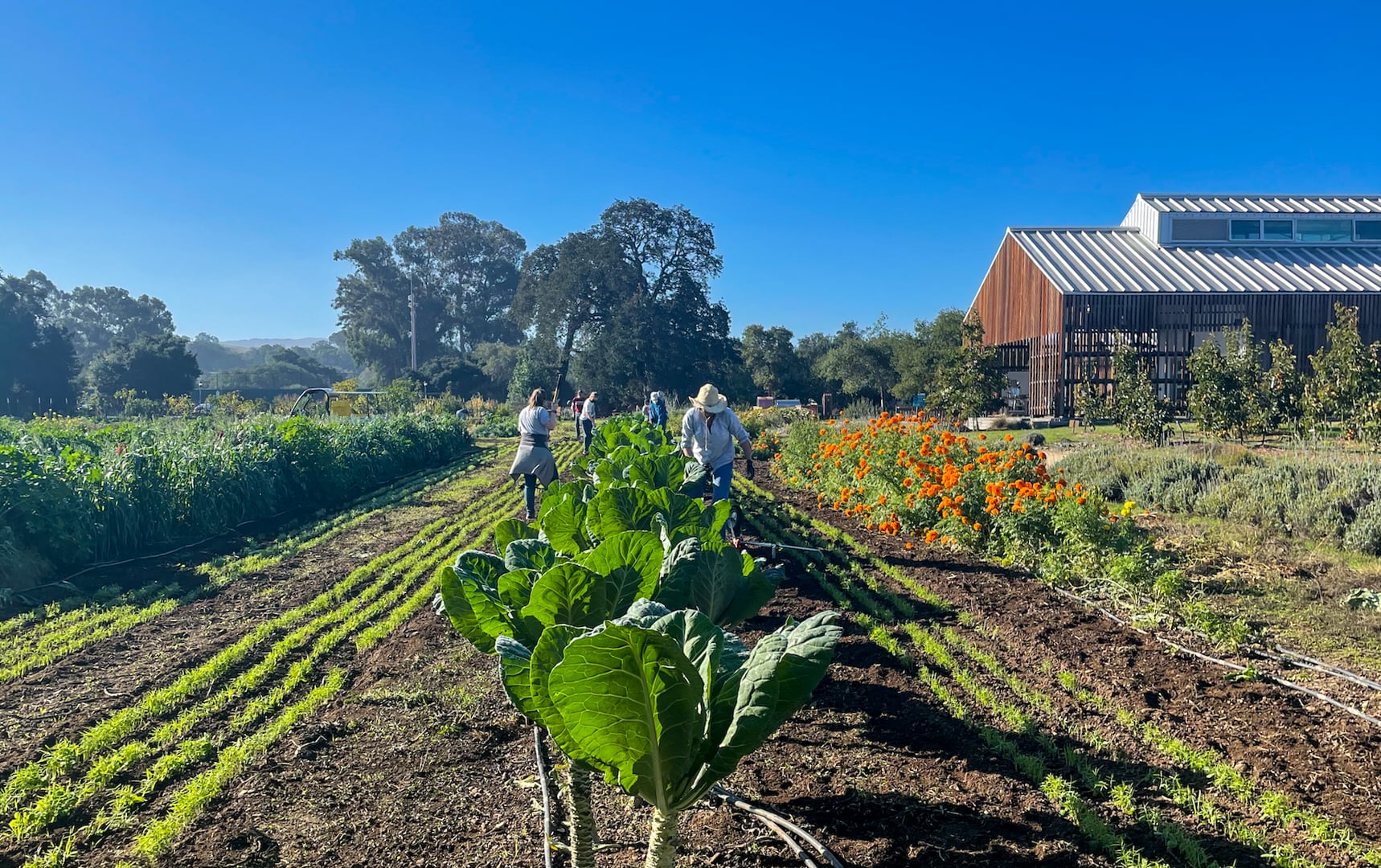At the farthest edge of West Campus, the O’Donohue Family Stanford Educational Farm offers an oasis for student volunteers and community members who help maintain its colorful rows of wildflowers and plants, harvest fruits and vegetables and create flower bouquets every Wednesday and Saturday morning. The majority of the produce is sent to the dining halls and the Teaching Kitchen, or donated to local food organizations to help alleviate food insecurity in the Bay Area.
“My favorite part of working here is just seeing such a diverse group of people come to the farm, and put their hands in dirt and get really excited about it,” said a student staff member who leads volunteers, as she pulled onion roots out of the soil and seeded garlic. “A lot of people end up just really falling in love with the Earth.” The student staff member was granted anonymity due to personal safety concerns unrelated to comments in the article.
The six-acre farm grows over 200 varieties of fruits, vegetables, flowers, herbs and field crops. Over the course of a year, the farm produces over 15,000 pounds of produce.
Tucked away on Stanford’s bustling campus, students say that the biodiverse Educational Farm has allowed them to breathe, relax and connect to one another and the land.
“Doing routine activities, especially outside, can feel really meditative. When you are weeding, the main thought on your mind is ‘pull full root out.’ You can kind of put your brain in that headspace, and that to me is really therapeutic,” said Lesley Jin ’24, a design major pursuing her coterminal degree in earth systems.
“During weeding, your brain just shuts off, which I think is very important at Stanford — to not think about academic or career stressors. [Here,] I don’t feel like I’m at Stanford. It feels like its own isolated farm really,” the student staff member said.
Volunteer tasks vary from week to week, according to the Eventbrite volunteers use to sign up for shifts. Besides weeding, tasks include planting new crop rotations, deheading flowers, composting, mulching and working on the irrigation system.
Beyond its meditative value, volunteers emphasized that working at the farm provides a meaningful social activity. “Whenever you catch up with friends, it’s always over a meal, but I love that at the farm, you can do something productive like be in touch with nature while catching up,” said Vyoma Sahani, a research assistant at the School of Medicine. “It’s a social activity that is also productive for Stanford and the farm and yourself. There’s a win-win, and win for society.”
On Saturday, students conversed about a variety of subjects while sitting among rows of kale — ranging from light conversations about weekend plans to deep philosophical discussions about sustainability, the meaning of the land to each individual, agroecology, the role of humans in maintaining the natural world and Indigeneity.
Sahani said that volunteering has spotlighted the issue of food waste, inspiring her to begin composting. “It takes so much effort just to grow one small patch of garlic, so it’s important to be really mindful. Whenever I am buying my groceries, I try to be very careful about how much I need.”
For the student staff member, who lives in Washington, tending to the land has personal significance.
“I came to the farm because gardening has always been very close to my heart,” she said. “My parents are very self-sustainable people, and I live in a home with a big backyard that has many fruit trees and vegetable gardens. When I came to Stanford, I wanted to learn more and be able to return home and help my family. Spending so much time here does really help center my brain around sustainability in general, and how I can use the Earth and take care of it, while taking care of myself,” she added.
Other students emphasized that working at the farm has lended them a new appreciation for the value inherent to the land on which they live, work and attend school.
Stanford’s campus sits within the traditional territory of the Muwekma Ohlone tribe. Leland Stanford purchased the land in the late 19th century. At many University gatherings, a student, faculty member or other speaker will read a land acknowledgment developed in collaboration with the Muwekma Ohlone tribe.
“I think everyone at Stanford should be required to learn about the land, and also understand whose land it is, and the history of it,” said Sophia Manolis ’24, an urban studies major with an interest in environmental justice. “I’ve been going to the Muwekma Four Directions Garden as well, and being here just reminds me of the importance of learning about land and how we can heal ourselves and past harms.”
For other students such as Megan Chen ’25, who is majoring in urban studies and architectural design, the farm offers “hands-on opportunities” to engage with her academic interests in sustainable food systems and urban gardening.
“Our farm, although not entirely an urban garden, has many of the same principles. We’re growing a lot of different plants in very close proximity to each other, learning more about what types of plants grow well in this area, how to effectively grow in smaller spaces, and different sustainable farm management techniques that are applicable in different projects that I am working on,” Chen said.
Beyond gaining exposure to different sustainability focused research projects and connecting to nature, coming together to volunteer has allowed students to grow their network and discover community.
“The farm community is one of the most welcoming, open and friendly communities at Stanford,” Chen said.
